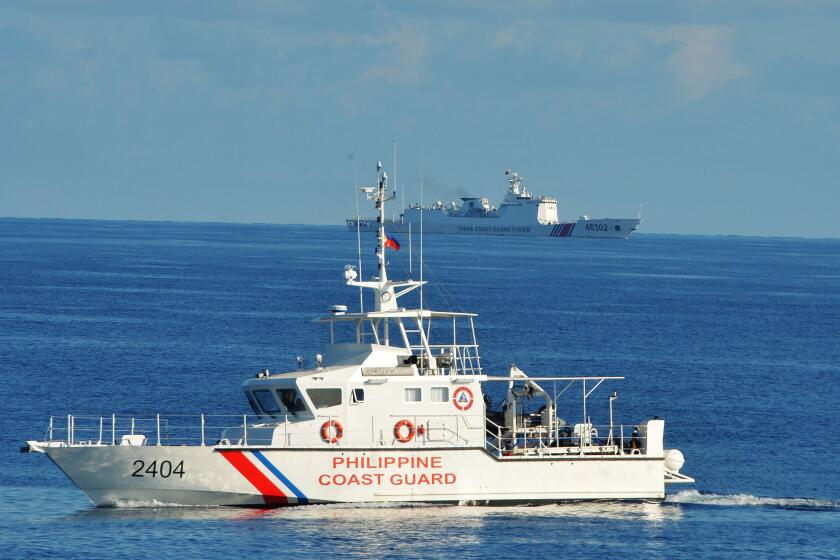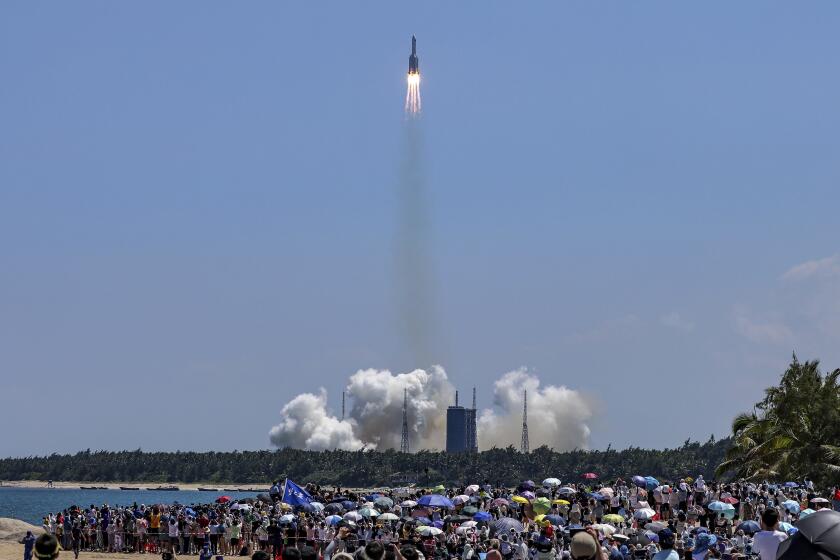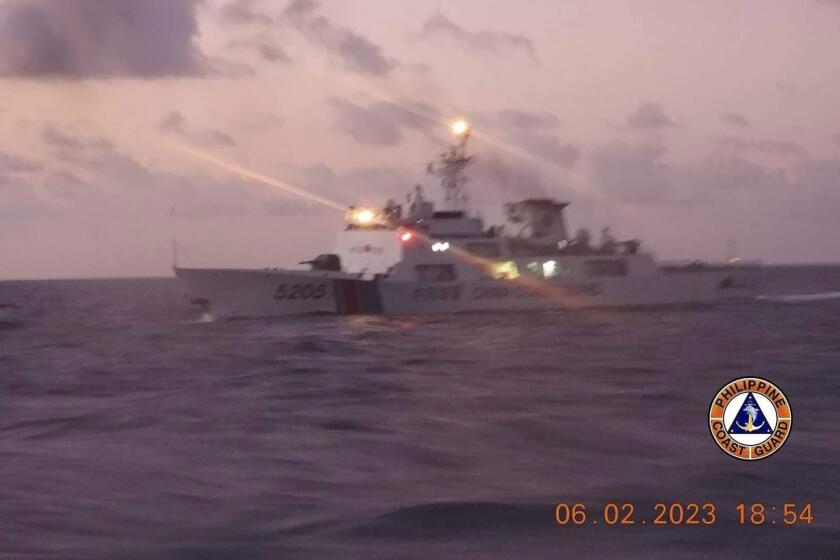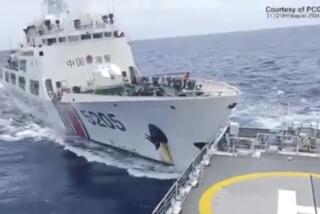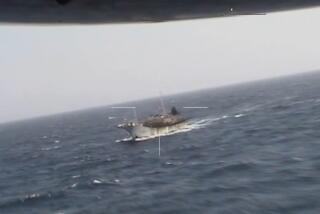Philippines confronts China over South China Sea claims in tense encounters
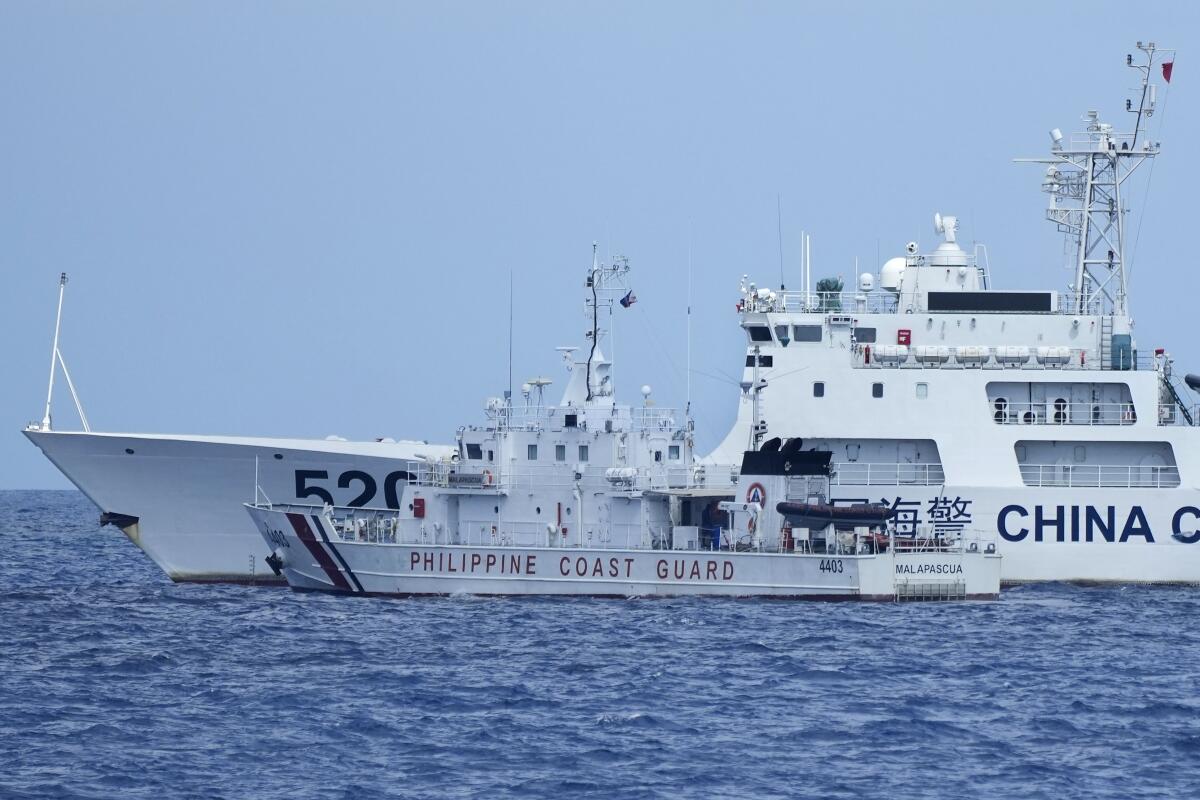
ABOARD BRP MALABRIGO — A Chinese coast guard ship blocked a Philippine patrol vessel steaming into a disputed shoal in the South China Sea, causing a frightening near-collision in the latest act of Beijing’s aggression in the strategic waterway.
The high-seas face-off Sunday between the larger Chinese ship and the Philippine coast guard’s BRP Malapascua near Second Thomas Shoal was among the tense moments it and another Philippine vessel encountered in a weeklong sovereignty patrol in one of the world’s most hotly contested waterways.
The Philippine coast guard had invited a small group of journalists, including three from the Associated Press, to join the 1,038-mile patrol for the first time as part of a new Philippine strategy aimed at exposing China’s increasingly aggressive actions in the South China Sea, through which an estimated $5 trillion in global trade transits each year.
In scorching summer heat but relatively calm waters, the Malapascua and another Philippine coast guard vessel, the BRP Malabrigo, journeyed to the front lines of the long-seething territorial conflicts. They cruised past a string of widely scattered Philippine-occupied and -claimed islands, islets and reefs looking for signs of encroachment, illegal fishing and other threats.
In areas occupied or controlled by China, the Philippine patrol vessels received radio warnings in Chinese and halting English, ordering them to immediately leave what the Chinese coast guard and navy radio callers claimed were Beijing’s “undisputable territories” and issuing unspecified threats against defiance.
Hostilities peaked Sunday morning in the Philippine-occupied Second Thomas Shoal in the Spratly archipelago, the most fiercely contested region in the busy sea channel.
China’s aggressive military activity in the disputed waterway has continued even as it seeks a global leadership role fighting the pandemic.
As the two patrol vessels approached the shoal’s shallow turquoise waters for an underwater survey, the Chinese coast guard repeatedly warned them by radio to leave the area, which is about 121 miles west of the Philippine island province of Palawan.
After several radio exchanges, a Chinese coast guard caller, sounding agitated, warned of unspecified adversarial action.
“Since you have disregarded our warning, we will take further necessary measures on you in accordance with the laws and any consequences entailed will be borne by you,” the Chinese speaker said.
A Chinese coast guard ship rapidly approached and shadowed the smaller Malapascua and the Malabrigo. When the Malapascua maneuvered toward the mouth of the shoal, the Chinese ship suddenly shifted to block it, coming as close as 120 to 150 feet from its bow, said the Malapascua’s skipper, Capt. Rodel Hernandez.
Debris from a rocket that boosted part of China’s new space station reportedly fell in a western Philippine province.
To avoid a collision, Hernandez abruptly reversed his vessel’s direction, then shut off its engine to bring the boat to a full stop.
Filipino personnel aboard the vessels — and journalists, who captured the tense moment on camera — watched in frightened silence. But the Malapascua steered aside just in time to avoid a potential disaster.
Hernandez later told journalists that the “sudden and really very dangerous maneuver” by the Chinese coast guard ship had disregarded international rules on collision avoidance. He had the Philippine vessels leave the area after the encounter for the safety of the ships and personnel.
Earlier, a huge Chinese navy ship shadowed the two Philippine patrol vessels in the dark of night as they cruised near Subi, one of seven barren reefs China has transformed in the last decade into a missile-protected island base. The Chinese navy ship radioed the Philippine vessels “to immediately leave and keep out.”
Start your day right
Sign up for Essential California for the L.A. Times biggest news, features and recommendations in your inbox six days a week.
You may occasionally receive promotional content from the Los Angeles Times.
The coast guard radioed back to assert Philippine sovereign rights to the area before steaming away.
China has long demanded that the Philippines withdraw its small contingent of naval forces and tow away the actively commissioned but crumbling BRP Sierra Madre. The navy ship was deliberately marooned on the shoal in 1999 and now serves as a fragile symbol of Manila’s territorial claim to the atoll.
Chinese ships often block navy vessels delivering food and other supplies to the Filipino sailors on the ship, including just a few days earlier, Hernandez said.
As hostilities between Chinese coast guard and navy ships and the Philippine patrol vessels were unfolding, Chinese Foreign Minister Qin Gang was in Manila, where he held talks with his Philippine counterpart and President Ferdinand Marcos Jr. on Saturday. China was willing to work with the Philippines to resolve differences and deepen ties, Qin said.
Manila has accused a Chinese ship of using a laser to temporarily blind crew aboard a Philippine coast guard vessel in the disputed South China Sea.
The Chinese Embassy in Manila did not immediately respond to an AP request for comment on the encounters.
Faced with a militarily far-superior China in the disputed waters, the Philippines launched the campaign early this year to expose Beijing’s aggression, hoping that public awareness and criticism will force the ruling Communist Party to abide by international law.
“We are David,” Philippines coast guard spokesperson Commodore Jay Tarriela said, likening the Philippines to the underdog hero of the biblical story. “We believe that through the publication of all these aggressive actions of China, we would find friends who would criticize Goliath.”
The territorial conflicts involving China, the Philippines, Vietnam, Malaysia, Taiwan and Brunei have long been regarded as an Asian flashpoint and a delicate fault line in the rivalry between the U.S. and China in the region.
The Philippines introduces an all-female coast guard radio unit as it challenges Chinese aggression in the South China Sea after years of inaction.
While the U.S. lays no claims to the South China Sea, it has deployed its warships and fighter jets for patrols and military exercises with regional allies to uphold freedom of navigation and overflight, which it says is in America’s national interest.
Beijing has criticized a recent agreement by the Philippines and the U.S. to grant American forces access to additional Filipino military camps. China fears the access will provide Washington with military staging grounds and surveillance outposts in the northern Philippines across the sea from Taiwan, which Beijing claims as its territory, and in provinces facing the South China Sea, which Beijing claims virtually in its entirety.
More to Read
Sign up for Essential California
The most important California stories and recommendations in your inbox every morning.
You may occasionally receive promotional content from the Los Angeles Times.
